I had the good fortune, this year, to be invited to present a little seminar at Beervana. Given the title Get More From Your Beer, the idea was to help wrap up the final (Saturday evening) session with a bit of a ramble on making the most of your beer-drinking experience with a few notes on commonly-confusing topics like “proper” glassware and temperature. There’s a lot of beer-drinking advice out in the wild, so I wanted to distill some of the best of it down, and simplify things a little, trying to empower people to resist some of the worst bits of snobbery and taking things way too seriously. For me, it amounts to this: drink beer with your brain engaged.
I made a few simple slides, and thought I should put a version of the seminar (which really is far too formal a word for drinking a few beers and rambling for a while) up here. It’s a little lengthy — I apparently speak at a fair rate of words-per-minute — but I offer it in the hopes it’ll help.
— The Fundamentals

Embrace subjectivity: Beer, like all matters of taste, is a subjective experience and you should absolutely embrace it as one of life’s rare opportunities where you are guaranteed to not be wrong. If you like it, you like it; if you don’t, you don’t. No one can peer into the inner workings of your noggin and tell you otherwise.
Understand its limits: But there’s a world of difference between you liking something and it being good — in fact it’s hard to find a genuine sense in which the latter can be objectively true in a domain such as this. So don’t browbeat people with tastes unlike your own, and don’t ever put up with a disdainful look shot in your direction over a mere difference in subjective experience.
Arm yourself with a little knowledge: Beer’s a richly varied and fractally interesting thing, but it’s always struck me (as against, say, wine or literature or technological gadgetry) as a subject which disproportionately rewards even a little knowledge. A good-enough familiarity with the canonical styles will let you decide whether you think the beer “does what it says on the tin” — as close to a criteria for objective goodness as we’ll ever get — and some idea of their usual intended timings and pairings will help you judge a beer on its best form.1 Some thought given to glassware and temperature will also be surprisingly effective at improving the experience (but we’ll get to that in a second) and it’s always worth having a quick look at the brewers’ own suggestions or what your fellow drinkers have to say — as long as you don’t let their words become Commandments.
Experiment, and pay attention: If, in the end, you enjoy something ‘abnormally’ and against the usual recommendations, that’s fine. You still bought the damn beer; it’s yours, and the brewery benefits from the sale no matter what the hell you do with their product.2 You just have to keep track of what you like, and how you like it. That’s possibly easy for people with memories that function within the bounds of Human Normal, but I had to resort to taking notes — and I can’t be the only one, and it’s a task made massively easier by the ubiquity of smartphones and websites like RateBeer and Untappd, if you think pen-and-paper just way too passé. (And if all other memory-aids fail, start a blog. I’ve had heaps of fun with this one.)
— Glassware
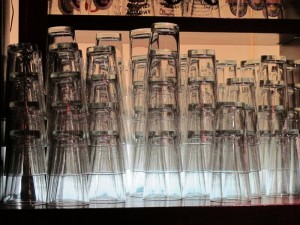
Rule Number One: Use a glass. It really is that simple. In my bartending days, the frequency and smugness with which all-too-many people would turn down a glass for their bottled beer with the worn-out joke “it’s already in a glass” was deeply depressing. This is a basic confusion of adjectives for nouns,3 and anyone making it should be sentenced to spend a week back in primary school, trying to bend themselves into fitting those teeny little desks and chairs. Giving up on a glass is giving up on seeing your beer basically at all, and on getting its aroma in anything but the weakest hint of a waft. You have more than one sense, and it’d be a shame to not put them to use.
Rule #2 & #3 to Rule #∞: From here, things threaten to get massively complicated. There’s a dizzying array of glassware varieties available and no danger of a global shortage on advice of what “must” go in what. But I don’t have the memory to keep them all straight, nor do I have the money to make sure I own a few of each. And it really needn’t be that difficult:
- Tall-ish glasses for beers which are: lighter (pale colours shine brighter), livelier (carbonation will be emphasised and you’ll get better head retention), simpler and more focused on being thirst-quenching — like pilsners and other pale lagers, most wheat beers and pale ales at the easier end of the spectrum.
- Wide-ish glasses for beer which are: heavier (the beer will be able to warm a bit…), more complex (swirling in a nicely bulbed glass will really bring out aroma), slower and more of a sit-and-sip affair — like bigger pale ales, porter / stout, darker Belgians, etc..
That’ll serve you really well for starters, and won’t amount to a cause of stress on mind or wallet. There’s also lot of specialty and/or branded glassware around, and it’s nice to slowly assemble a collection, but they’re mostly just for fun. Some of them probably aren’t even “right” for their own beers: a chunky hexagonal Hoegaarden tumbler is rather striking but rubbish at preserving the beer’s soft bubbly head and the classic heavy beer-hall mass doesn’t do pale German lager any real favours — the size of them is more about ease of serving seven million litres of beer to as many people over Oktoberfest; their heft and handle are meagre concessions against having your beer go warm and gross as you drink.
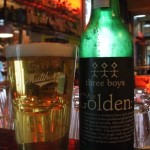
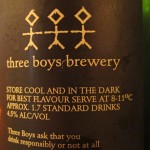
As a Test Beer, we had a Three Boys Golden; a thing of pure marvellousness and an illustrative borderline case. Golden ales could go either way, depending on your mood and where they land on the spectrum — you could have one as a “lawnmower beer”4 or in a more contemplative mood. The one in the photo is also in a “Boston glass”, which is pretty standard in bars around here (and descends from half of a cocktail shaker, weirdly). They — like most beer festival glassware — are just exercises in compromise, really; usually both tall-ish enough and sufficiently wide-ish for most purposes. Finally, I think it’s a great case of how you should listen to — but not uncritically accept — the brewers’ suggestions: the label is bang on with its advice about how to store your bottles and with its plea that you drink like a grown-up, but I think that 8-11°C is way too warm for this beer…5
— Temperature
There’s no crucially important Rule Number One, here, comparable to the one there was with glassware. Once you’ve been convinced to pour your beer into a glass, and hopefully a vaguely suitable — and clean — one at that, you’re way ahead of the game and temperature will only be a secondary consideration. That said, there are two crappy suggestions worth dynamiting for good:
-
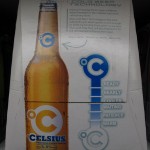
Boundary Road ‘Celsius’ Very, very cold indeed: Mainstream beers (and pale lagers especially) will often imply or outright declare that their beer is best damn near freezing point. Embarrassingly-many beer brands offer an elaborately-dispensed “Extra Cold” variant, but you just can’t physiologically taste much of anything down around zero degrees.6 Which is, of course, mostly the (unspoken) point; these are brands, not beers — they’ve given up on competing on flavour, concentrating instead on nonsense like product x being for Proper Southern Men and product y being for Urban Sophisticates.
- Surprisingly warm: You can’t tend bar in the Antipodes for long without being lectured at length by a Briton who is adamant that the beer’s too cold and that proper beer (particularly “real ale”) should be dispensed at “room temperature”. This was never the case and overlooks the historical reality of beer being stored at cellar temperature — i.e., closer to 12° than the 22°-ish usually considered ideal ambient room temperature. If you or your friends live at cellar temperature, you are probably considered “in poverty” and eligible for government assistance, and perhaps shouldn’t be wittering your money away on luxuries like real ale.
The truth lies somewhere in the middle, and could generously be signposted as 4°-14° ish, broadly with lower temperatures for refreshing lighter beers and warmer ones for darker and more brooding sippers — quite nicely analogous and aligned, in a helpful coincidence, to the split outlined above for glassware. In general, thanks to various bits of physics you might remember from school, warmer temperatures will bring out more aroma and allow more carbonation to escape (i.e., the beer will feel flatter to drink) and will enhance (or just reveal) more flavour/s. Human sensitivity to sweetness and bitterness, particularly, increases with temperature and it’s not completely mad to say that beer is about the interplay of those two main basic tastes — so beers with depth and complexity will benefit enormously from a few more degrees Celsius. But more of everything will come out, including the fumey volatility that some higher-strength beers possess and the various faults the brewing process can kick up, so it’s very much a try-it-and-see situation.
For our Test Beer, here, we had Moa’s bloody-terrific Imperial Stout. It’s a brilliant behemoth of a thing, at 10+% and aged in Pinot Noir barrels. I think they’re going too far to suggest it be served “just below room temperature”, but it’s true that it has masses more character when served warmer, but so much so that some people preferred it cold. As with everything else: to each their own. And the beer’s a nice reminder that you should keep experimenting, and keep an open mind; Moa do a lot, marketing-wise, to enrage me — but they can still make a beer of real genius, one worthy of setting aside your anti-brandwank principles and not letting them turn into a complete boycott.
Again, the point is to keep the basic spectrum in mind, but not to stress out too much. Much-mourned beer-writing legend Michael Jackson (i.e., not one of the other ones) wrote about a five-category range of ideal serving temperatures, but the first three steps were separated by only a single degree Celsius each. Which is madness. I have plenty of gadgets, but a thermometer isn’t among them, and hardly anyone knows the precise temperature of their fridge — and if you’re drinking remotely-normal quantities in even-only-vaguely-normal conditions, your beer will slip between brackets on that scale as you drink. In my experience, taking a beer out of the fridge for a few minutes before opening it makes it nicely ‘cool’ but not too cold — and putting a beer in the fridge for a few minutes after storing it in a dark cupboard nicely approximates “cellar temperature”.7 Again; muck about, pay attention, and see how you go.
— Back to Fundamentals
Embrace subjectivity, within its proper limits. Arm yourself with a little knowledge — about styles, timing, glassware and temperature, but especially about what you yourself happen to enjoy. And if you’re in a bar and your desired way of doing things isn’t their usual way of doing things — if you want your beer warmer, cooler, or in a different glass than the bartender is reaching for — then you should damn-well feel entitled to say so. If they’re snobbish or uncooperative in response, find yourself another, better bar.
1: If you happen to not like a certain barleywine, for example, and you were tasting it at nine in the morning or while eating and explosively-hot curry (or, heaven forbid, both) then that’s probably more your fault than its, for dragging it so far from its ecological niche. (But, equally, if that’s how you like your barleywine… then by all means go nuts. Weirdo.)
2: Since there’s some considerable crossover among the fans of malted-barley-based beverages, I’ll happily say the same heretical thing about whisky. If you like yours with ice, or with Coke — or served in a Man’s hat, in which floats a single plum — I really don’t care. I usually take mine with a touch of water, or maybe a little ice cube, and I’d probably say that a subtle single malt is just money wasted if you’re mixing yours with sugary soda. But a sale is a sale, and brewing and distilling are precarious businesses which can use your cash to survive and keep snobbier drinkers supplied with booze.
3: It’s in a bottle made of glass. Similarly, I don’t live in “a wood”; I live in a house made of wood.
4: The usual nickname for the style is “Thinking Man’s Lager”, which is a) horribly snobbish, b) needlessly gendered, but still c) fairly close to the truth.
5: But again; if you like yours that warm, or warmer — go nuts.
6: The evidence also seems to be that if you’re actually exhausted — rather than just the sort of person to whom the “brand story” appeals — then drinks under around 4° are less refreshing. So the brandwank isn’t just lame, it’s unusually counterproductive.
7: Only use the freezer in emergencies and if you have excellent task memory / a timer of some kind handy; frozen beer is basically irretrievably fucked and won’t thaw back to normal.

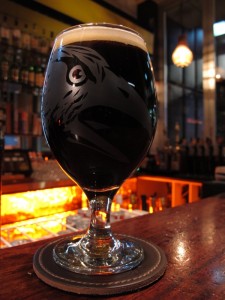
Kieran said it was a good ‘un. He was right. Well said sir.
Shame I missed this. Knew you’d fit this seminar perfectly. Heard great things and Jess was well impressed.
It was a good un, even more so to see Sarah Bennett enligtened by Phil at the presentation (due to all the ‘its subjective’ ‘your opinion is right’ stuff) and then crushed afterwards when he showed alarm that she didnt like Watermelon Warhead 🙂
I’m with Ralph on the Temp for Golden by the way 🙂
…. I am probibly mad tho, everyone says it .